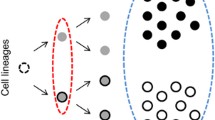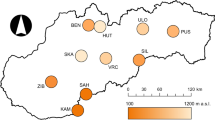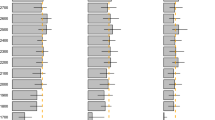Summary
Environmental conditions can influence the expression and correlations of phenotypic traits. I studied phenotypic plasticity in reproductive traits of Western Bluebirds breeding in northern Arizona. Data collected over 4 years on two contrasting habitats identified significant spatial and temporal variation in bluebird reproduction. Clutch size was similar over different environmental conditions whereas timing of clutch initiation, percent fledging success, and frequency of second nest attempts were flexible. Correlations between traits varied widely—often changing sign—among samples from different years or habitats. Correlations of traits with reproductive success were also dependent on environmental conditions. Variation in traits reflected behavioral responses by nesting adults to differences in time for breeding and feeding conditions. Density of trees differed between habitats and had opposing effects on these environmental variables; breeding seasons were generally longer, but feeding rates to nestlings were lower on the more open habitat. Late Spring snows delayed reproduction and increased the importance of limited time for breeding; feeding conditions were more influential following a dry Spring. This and other studies illustrate that data on phenotypic plasticity are important when evaluating the ecological and evolutionary forces underlying life histories.
Similar content being viewed by others
References
Arcese P, Smith JNM (1988) Effects of population density and supplemental food on reproduction in Song Sparrows. J Anim Ecol 57: 119–136
Balen JH van (1973) A comparative study of the breeding ecology of the Great Tit (Parus major) in different habitats. Ardea 61: 1–93
Berven KA (1982) The genetic basis of altitudinal variation in the wood frog Rana sylvatica. I. An experimental analysis of life history traits. Evolution 36: 962–983
Brawn JD (1987) Density effects on reproduction of cavity nesters in northern Arizona. Auk 104: 783–787
Brawn JD (1988) Selectivity and ecological consequences of cavity nesters using natural versus artificial nest sites. Auk 105: 789–791
Brawn JD, Balda RP (1988) Population biology of cavity nesters in northern Arizona: do nest sites limit breeding densities? Condor 90: 61–71
Cameron GN, McClure PA (1988) Geographic variation in life history traits of the Hispid cotton rat (Sigmodon hispidis). In: Boyce MS (ed) Evolution of life histories of mammals. Yale University Press, New Haven, pp 33–64
Caswell H (1983) Phenotypic plasticity in life history traits: demographic effects and evolutionary consequences. Am Zool 23: 35–46
Dingle H (1984) Behavior, genes, and life histories: complex adaptations in uncertain environments. In: Price PW, Slobodchikoff C, Guad W (eds) A new ecology: novel approaches to interactive systems. John Wiley and Sons, New York, pp 169–194
Dobson FS, Murie JO (1987) Interpretation of intraspecific life history patterns: evidence from Columbian ground squirrels. Am Nat 129: 382–397
Drent RH, Daan S (1980) The prudent parent: energetic adjustments in avian breeding. Ardea 68: 225–252
Ford NB, Seigel RA (1990) Phenotypic plasticity in reproductive traits: evidence from a viviparous snake. Ecology 70: 1768–1774
Gezelius L, Grahn M, Källander H, Karlsson J (1984) Habitatrelated differences in clutch of the Pied Flycatcher Ficedula hypoleuca. Ann Zool Fenn 21: 209–212
Gillespie JH, Turelli M (1989) Genotype-phenotype interactions and the maintenance of polygenic variation. Genetics 121: 129–138
Grime JP (1977) Evidence for the existence of three primary strategies in plants and its relevance to ecological and evolutionary theory. Am Nat 111: 1169–1194
Herlugson CJ (1982) Food of adult and nestling Western and Mountain Bluebirds. Murrelet 63: 59–65
Holm E (1988) Environmental restraints and life history strategies: a habitat templet matrix. Oecologia 75: 141–145
James FC (1983) Environmental component of morphological differentiation in birds. Science 221: 184–186
Lack D (1966) Population studies of birds. Oxford University Press, London
Lande R (1982) A quantitative genetic theory of life history evolution. Ecology 63: 607–615
Lundberg P (1987) Breeding seasons of north Scandinavian Starlings (Sturnus vulgaris): constrained by food or time? J Anim Ecol 56: 847–855
Martin TE (1986) Competition in breeding birds: on the importance of considering processes at the level of the individual. Curr Ornith 4: 181–210
Møller AP (1984) Geographical trends in breeding parameters of Swallows Hirundo rustica and House Martins Delichon urbica. Ornis Scand 15: 43–54
Morton ML, Horstmann JL, Osborn JM (1974) Reproductive cycle and nesting success of the mountain White-crowned Sparrow (Zonotrichia leucophrys oriantha) in the central Sierra Nevada. Condor 74: 152–163
Murphy EC, Haukioja E (1986) Clutch size in nidicolous birds. Curr Ornith 4: 141–180
Murphy MT (1986) Temporal components of reproductive variability in Eastern Kingbirds (Tyrannus tyrannus) Ecology 67: 1483–1492
Myers RA, Hutchings JA (1987) A spurious correlation in an interpopulation comparison of Atlantic salmon life histories. Ecology 68: 1839–1843
Nilsson SG (1984) The evolution of nest-site selection among holenesting birds: the importance of nest predation and competition. Ornis Scand 15: 167–175
Noordwijk AJ van (1989) Reaction norms in genetical ecology. Bio-Science 39: 453–458
Noordwijk AJ van, Balen JH van, W Scharloo (1981) Genetic variation in the timing of reproduction in the Great Tit. Oecologia 49: 158–166
Nur, N (1987) Alternative reproductive tactics in birds: individual variation in clutch size. In: Bateson PPG, Klopher PH (eds) Perspectives in ethology, vol 7. Plenum, New York, pp 49–78
Partridge L, Harvey PH (1988) The ecological context of life history evolution. Science 241: 1449–1455
Perrins C (1970) The timing of birds' breeding seasons. Ibis 112: 242–255
Perrins C, McCleery RH (1989) Laying dates and clutch size in the Great Tit. Wilson Bull 101: 236–253
Power HW (1980) The foraging behavior of Mountain Bluebirds with emphasis on sexual foraging differences. Ornith Monogr Number 28
Rotenberry JT, Wiens JA (1989) Reproductive Biology of shrubsteppe passerine birds: geographical and temporal variation in clutch size, brood size, and fledging success. Condor 91: 1–14
Scharloo W (1989) Developmental and physiological aspects of reaction norms. BioScience 39: 465–471
Schlichting CD (1986) The evolution of phenotypic plasticity in plants. Ann Rev Ecol Syst 17: 667–693
Schlichting CD (1989) Phenotypic plasticity in Phlox II. Plasticity in character correlations. Oecologia 78: 496–501
Slagsvold T (1984) Clutch size of birds in relation to nest predation: on the cost of reproduction. J Anim Ecol 53: 945–953
Sokal RR, Rohlf FJ (1981) Biometry, second edition. WH Freeman, San Francisco
Southwood, TRE (1988) Tactics, strategies and templets. Oikos 52: 3–18
Stearns SC (1984) The effects of size and phylogeny on patterns of covariation in the life history traits of lizards and snakes. Am Nat 123: 56–72
Stearns SC (1989) The evolutionary significance of phenotypic plasticity. BioScience 39: 436–445
Tinbergen JM (1987) Costs of reproduction in the Great Tit: intraseasonal costs associated with brood size. Ardea 75: 111–122
Via S, Lande R (1985) Genotype-environmental interaction and the evolution of phenotypic plasticity. Evolution 39: 505–522
West-Eberhard MJ (1989) Phenotypic plasticity and the origins of diversity. Ann Rev Ecol Syst 20: 249–278
With KA, Balda RP (1990) Intersexual variation and factors affecting parental care in Western Bluebirds: a comparison of nestling and fledgling periods. Can J Zool 68: 733–742
Zink RM, Remsen JV Jr (1986) Evolutionary processes and patterns of geographic variation in birds. Curr Ornith 4: 1–70
Author information
Authors and Affiliations
Rights and permissions
About this article
Cite this article
Brawn, J.D. Environmental effects on variation and covariation in reproductive traits of Western Bluebirds. Oecologia 86, 193–201 (1991). https://doi.org/10.1007/BF00317531
Received:
Accepted:
Issue Date:
DOI: https://doi.org/10.1007/BF00317531




